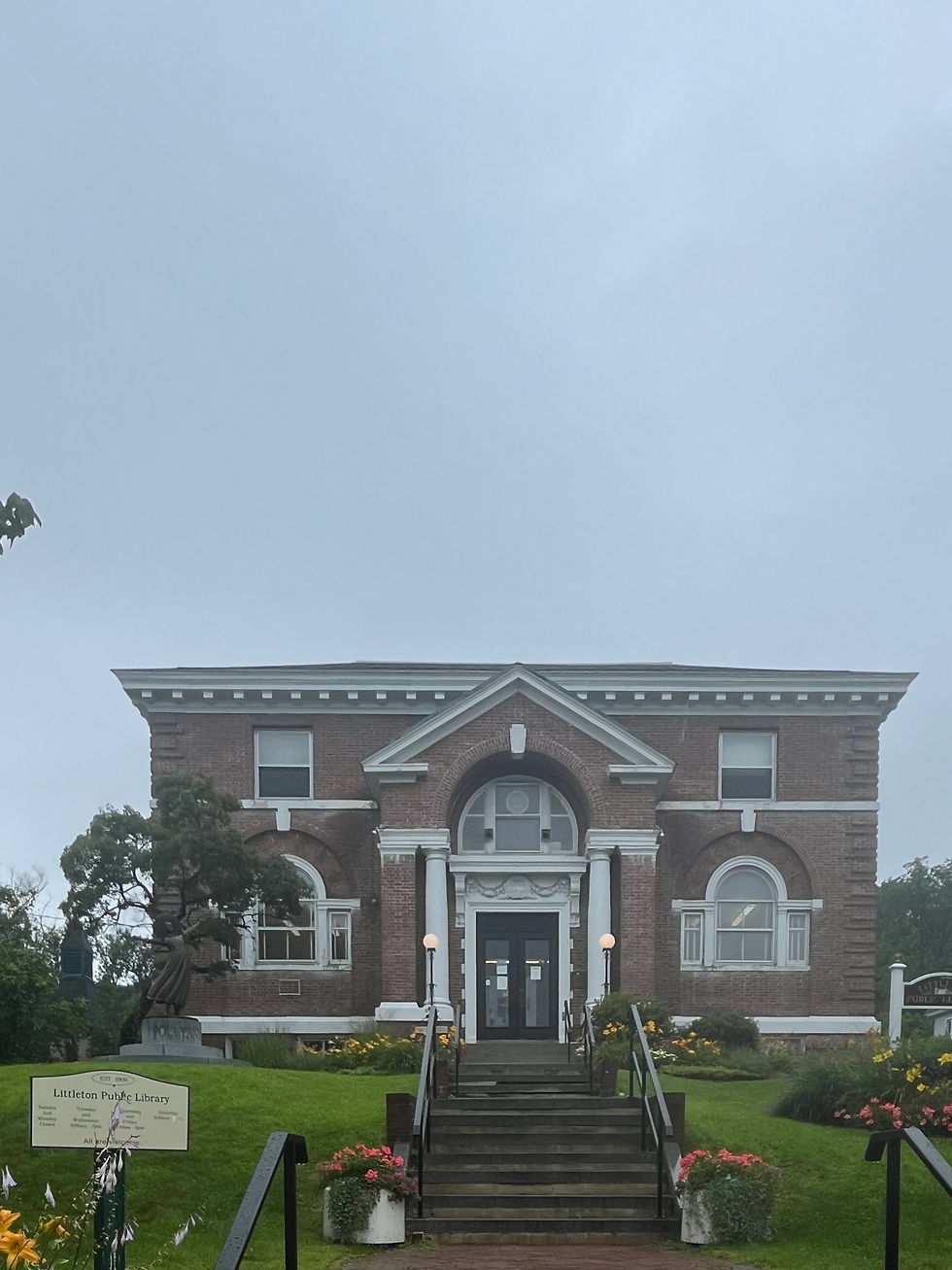Day 17, Friday, March 1, 2024: Oklahoma City, Oklahoma to Hobart, Oklahoma
- Mark Carl Rom
- May 10
- 7 min read
Carnegie libraries visited: El Reno and Elk City, Oklahoma
It was a three library day: the Patience Latting Library in OKC, followed by visits to the Carnegie libraries in El Reno and Elk City. I might have driven through Carnegie if it had a Carnegie library and, even though it tried to obtain one (the town’s founders renamed it after the industrialist in an effort to woo him), it did not succeed.
Patience Latting was neither a librarian nor a library founder, yet as her name is affixed to a library she merits a mention. After moving to Oklahoma City as an adult, Latting joined both the local Parent Teacher Association and the League of Women Voters, the latter preparing her for a career in politics. As a reformer and statistician (she had received a masters degree in statistics from Columbia University) she successfully led the efforts to reapportion the state’s legislative districts, which disproportionately favored rural areas over more urban ones. As an outsider, she defeated the establishment candidate to become the first female mayor of Oklahoma City and so, at that time, the head of the largest American city with a female mayor. Her opponent attributed Latting’s victory to her “outgoing personality” which, as we have seen, is a useful trait for a politician to possess. She served as mayor for 12 years before declining to run for another term. Her accomplishments led to her being inducted into the Oklahoma Hall of fame.
Not a Carnegie library, I visited the Patience Latting because it was recommended as the most beautiful library in Oklahoma. That recommendation was well-deserved. The library, opened in 2012 is built into a grassy berm. The exposed section is ringed with glass, so the library is full of light. Glass cones, built to resemble oil derricks, emerge from the roof. Inside, these derricks form rooms named “Reading,” “Lounge,” and so forth. Upcoming events included a conversation with Clare Westmacott as she discusses “In My Grandmother’s Footsteps: The War Diary of Klara Seuffert, 1940 to 1944” and “The Crowns Tea,” which celebrates the book Crowns: Portraits of Black Women in Church Hats. Libraries provide more than information; they can offer insight and inspiration.
As I’ve been on a mission to visit libraries, I rarely have explored any of the many wonders along my trail. Fort El Reno was one of them. I actually drove past the exit, had second thoughts, and did the u-turn to go back. I’m glad I did, and I’m guessing that my museum host Shirley was too, as I was her only visitor during the two hours I was there. She gave me an extensive oral history, which I did not write down, and now cannot recall. The fort was established to protect white settlers from the Cheyennes and Arapahos who had been moved to reservations in the area, although in reality it might have been better used to protect the tribes from the settlers. During WWII it served as a prisoner-or-war camp for Germans and Italians. The soldiers in the Afrika Korps built the fort's chapel.

Shirley told me that the fort’s cemetery was worth visiting, and so I drove along the dusty gravel road for the mile to reach it on the top of a gentle knoll, clusters of wind-swept conifers keeping sentry. The cemetery was divided into two parts, the larger for the Americans who died at the fort and the smaller one for the POWs. The first graves I encountered held the remains of children. Age 6, 1918. Age 4, 1918. Age 3, 1918. And on. It must have been a terrible year at the fort, in remote Oklahoma, with child after child dying from the Great Influenza (or some other malady) that struck that year.

The POW graves were arrayed along the walls of the smaller plot, the Gunters, Karls, and Werners separated from the Marios, Giovannis, and Lorenzos. Only a very few bodies had been repatriated. Those graves seemed so lonely, forever under the Oklahoma sun, so far from their childhood homes and the resting places of their families.

El Reno, in 1903, contained two of my loves under one roof: both the town library and its YMCA, “the secretary of the latter serving as the librarian, thus saving in expense.” When this was pointed out to Bertram, he responded that “Mr. Carnegie does not combine libraries with YMCAs.” Both sides persist with this line of argument for a couple more letters (Combining the library and the Y saves money! Carnegie will not fund such a combination!) before they settle down to an agreement. Carnegie writes a check for $12,500 and the library opens in 1905. Unlike the Perry website, the El Reno website mentions nothing about its history other than it was funded by the industrialist.
Elk City had the Culture Club, and the Culture Club wanted to have a library, so in 1911 its corresponding secretary – her name is illegible on the handwritten letter – wrote Carnegie to request one. This was not the first request from the town, as in 1908 a representative of the Western Lumber Company – his name is illegible on the otherwise typewritten note – had written to him with a similar request, without a response. Other letters from the locals followed.
Taking the book by the bindings, the literary equivalent of taking the bull by the horns, in 1912 a group of Presbyterian women (where this detail comes from is unclear to me, as I see no reference to the religion of the women elsewhere in the files; it appears only on the Best Public Libraries website) organized the Elk City Library Association and opened a one room lending library in one room of the building used by the Elk City Daily News. Carnegie awarded the town a grant, and its Carnegie library opened in 1915, with Mrs. Elizabeth Keen as its first librarian in the new building.

I pulled into Hobart, Oklahoma as the sun gently settled over the town. As in the other small towns I have visited, no one parks on the streets, and there were only two small hotels in town: one was unattractive and the other was tiny with no parking lot. After cruising around to find a spot unlikely to draw police attention, I settled for parking on the street by the DyerHouse (one word) hotel, hoping that passersby would assume that the car was for the hotel’s guest.
As the Esquire movie theater in Hobart had long since closed, I watched “Fury” on Netflix in the front seat of Goldfinger. Fury is the very model of a modern American World War II movie. Brad Pitt played “Wardaddy,” the hardened, brutal, cynical, stoic tank commander; Logan Lerman was in the role of Norman, the innocent and gentle machine gunner. In the movie’s climatic scene, their tank breaks down as an SS company approaches them. Staying at the tank would be suicidal. While his men prepare to flee, Wardaddy asserts that he’ll stay and defend the intersection where the tank is stuck. Norman says that he, too, will stay and then, of course, the others agree also to do so. A horrific battle follows, and all but Wardaddy and Norman are killed. Out of ammunition, and facing imminent death, Wardaddy tells Norman he can escape through a hatch under the tank and hide there. After Wardadday is killed, a young German soldier spots the terrified Norman under the tank and has mercy on him as the remaining SS march off. The next day, Norman is rescued by the Yanks, who call him a hero.
What makes this such an American movie is that it is just an updated version of “Remember the Alamo." Despite the American’s character flaws, they are noble heroes. Rather than fleeing the enemy, they stand their ground and fight to their certain deaths. Instead of the SS torturing and killing Norman – as they almost certainly would have done in real life – the Nazi youth has pity on him and does not capture him. Finally, the ratio of bad guys killed to good guys killed is very, very, high.
If Andrew Carnegie had his way, there would have been no movies about World War II, because there would have been no World War II and no World War I, either. After he retired, Carnegie devoted much of his time and talents (if not his fortune) to promoting world peace. To this end he established the Carnegie Endowment for International Peace with the largest endowment in history, and advocated for the creation of a League of Nations.
In many ways, Carnegie could comfortably be considered a liberal Democrat. He was an internationalist, an anti-imperialist, and a pragmatic pacifist (although a small portion of his riches came from producing steel armament for the US government). An immigrant himself, he supported increased immigration. He believed that institutions could and should be built to promote the public good. He supported an income tax when the wealthy of his generation did not. In a 1913 interview, Carnegie claimed that “I was one of the first to support it. Get my Gospel of Wealth and read what I have to say about it….I agree with Adam Smith…that large fortunes should be converted to the support of the nation.” He supported low tariffs, although only after he had amassed a vast fortune in some large part because of the tariffs. He supported an estate (“death”) tax, but he believed even more fervently that the wealthy should give away all their fortunes before they died to benefit the public.
Carnegie almost did that. By the time of his death, he had donated over 90 percent of his fortune, $350 million, and an additional $30 million was given away after he died. Adjusted for inflation, his net worth was a Musk-like $300 billion.
The idea that one should earn as much as one can, the better to help remedy the world’s most pressing problems by giving it away, received a burst of publicity in the mid-2010s under the rubric “effective altruism.” (The most famous, and then infamous, proponent was Sam Bankman-Fried, who went from being a billionaire to being convicted for fraud and conspiracy in a hot second.) Effective altruism has two main components. One concerns how money is earned. A person can earn a small salary as, say, a teacher or large fortune as, say, a crypto-currency mogul. The teacher can help only the students in their classroom, whereas if the mogul gives the fortune to for educational purposes they can help innumerable students. Virtue thus prefers the tycoon to the teacher because the tycoon helps more students than the teacher does.
The second element concerns the beneficiaries of the altruism. Some purposes are more important than others. Healing the sick takes priority over donating to the Met. Providing clean water is more important than adding to Harvard’s endowment. The Met and Harvard will argue that they, too, are important and a case can be made for that. But for the effective altruist, reducing misery trumps increasing pleasure. Carnegie no doubt believed that he was distributing his fortune wisely to broad public benefit. Those who worked in his steel mills might have wished that he cared more for their health and well-being.


















Comments